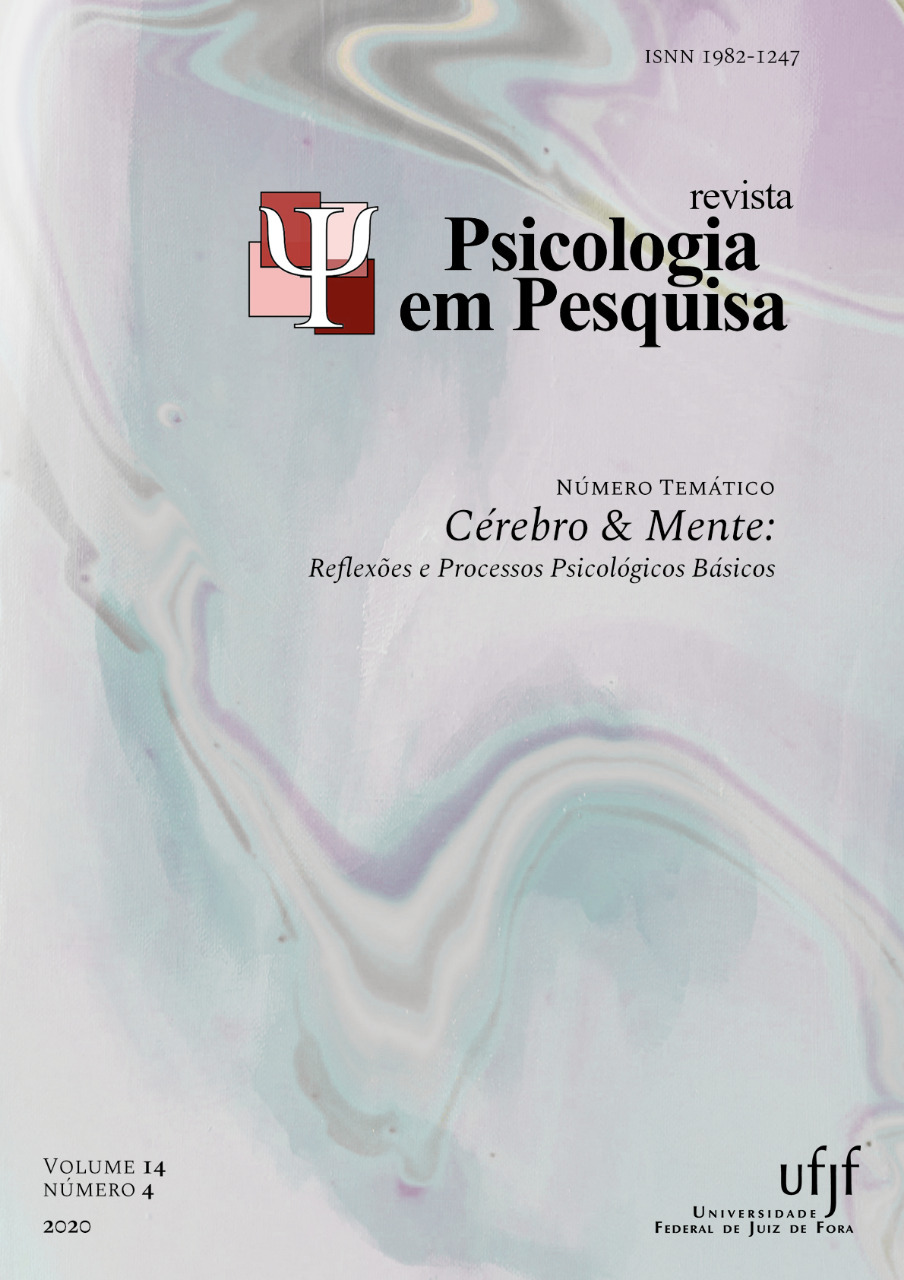Kuleshov Effect: The Influence of Emotional Context on Face Processing
DOI:
https://doi.org/10.34019/1982-1247.2020.v14.29122Abstract
In 1920, Lev Vladimirovitch Kuleshov reported that the emotional context juxtaposed with the neutral face could affect the face perception making it reported as emotional. In the cinema area, this phenomenon was denominate of Kuleshov effect. The existence of the effect is scientifically questionable, and neuroscientists are engaged in validating the Kuleshov effect. In this article we will summarize the different experimental models that have been used in the investigation of the Kuleshov effect and the results found so far through the scientific method; more precisely in experimental and neuroscience research.The results of these studies show some evidence, however, there is no complete proof of the Kuleshov effect.
Downloads
References
Baranowski, A. M., & Hecht, H. (2017). The Auditory Kuleshov Effect: Multisensory Integration in Movie Editing. Perception, 46(5), 624–631. https://doi.org/10.1177/0301006616682754
Barratt, D., Rédei, A. C., Innes-Ker, Å., & van de Weijer, J. (2016). Does the Kuleshov Effect Really Exist? Revisiting a Classic Film Experiment on Facial Expressions and Emotional Contexts. Perception, 45(8), 847–874. https://doi.org/10.1177/0301006616638595
Branigan, E. (1984). Point of View in the Cinema. Mouton de Gruyter.
Brothers, L. (1990). The neural basis of primate social communication. Motivation and Emotion, 14(2), 81–91. https://doi.org/10.1007/BF00991637
Calbi, M., Heimann, K., Barratt, D., Siri, F., Umiltà, M. A., & Gallese, V. (2017). How Context Influences Our Perception of Emotional Faces: A Behavioral Study on the Kuleshov Effect. Frontiers in Psychology, 8. https://doi.org/10.3389/fpsyg.2017.01684
Calbi, M., Siri, F., Heimann, K., Barratt, D., Gallese, V., Kolesnikov, A., & Umiltà, M. A. (2019). How context influences the interpretation of facial expressions: A source localization high-density EEG study on the “Kuleshov effect”. Scientific Reports, 9(1), 2107. https://doi.org/10.1038/s41598-018-37786-y
Giannetti, L., & Eyman, S. (2009). Flashback: A Brief Film History (6 edition). Boston, MA: Pearson Education/Allyn & Bacon.
Guo, K., & Shaw, H. (2015). Face in profile view reduces perceived facial expression intensity: An eye-tracking study. Acta Psychologica, 155, 19–28. https://doi.org/10.1016/j.actpsy.2014.12.001
Herring, D. R., Taylor, J. H., White, K. R., & Crites, S. L. Jr. (2011). Electrophysiological responses to evaluative priming: The LPP is sensitive to incongruity. 794–806. https://doi.org/10.1037/a0022804
Hietanen, J. K., & Astikainen, P. (2013). N170 response to facial expressions is modulated by the affective congruency between the emotional expression and preceding affective picture. Biological Psychology, 92(2), 114–124. https://doi.org/10.1016/j.biopsycho.2012.10.005
Leyda, J. (1983). Kino: A History of the Russian and Soviet Film (3 edition). Princeton, N.J: Princeton University Press.
MacKay, J. (2013). Built on a Lie: Propaganda, Pedagogy, and the Origins of the Kuleshov Effect. The Oxford Handbook of Propaganda Studies. https://doi.org/10.1093/oxfordhb/9780199764419.013.021
Mobbs, D., Weiskopf, N., Lau, H. C., Featherstone, E., Dolan, R. J., & Frith, C. D. (2006). The Kuleshov Effect: The influence of contextual framing on emotional attributions. Social cognitive and affective neuroscience, 1(2), 95–106. https://doi.org/10.1093/scan/nsl014
Neta, M., Davis, F. C., & Whalen, P. J. (2011). Valence resolution of facial expressions using an emotional oddball task. Emotion (Washington, D.C.), 11(6), 1425–1433. https://doi.org/10.1037/a0022993
Prince, S., & Hensley, W. E. (1992). The Kuleshov Effect: Recreating the Classic Experiment. Cinema Journal, 31(2), 59–75. https://doi.org/10.2307/1225144
Righart, R., & de Gelder, B. (2006). Context Influences Early Perceptual Analysis of Faces—An Electrophysiological Study. Cerebral Cortex, 16(9), 1249–1257. https://doi.org/10.1093/cercor/bhj066
Righart, R., & de Gelder, B. (2008). Rapid influence of emotional scenes on encoding of facial expressions: An ERP study. Social cognitive and affective neuroscience, 3(3), 270–278. https://doi.org/10.1093/scan/nsn021
Russell, J. A. (1980). A circumplex model of affect. Journal of Personality and Social Psychology, 39(6), 1161–1178. https://doi.org/10.1037/h0077714
Russell, J. E., & Fehr, B. W. (1987). Relativity in the Perception of Emotion in Facial Expressions. https://doi.org/10.1037/0096-3445.116.3.223
Schurgin, M. W., Nelson, J., Iida, S., Ohira, H., Chiao, J. Y., & Franconeri, S. L. (2014). Eye movements during emotion recognition in faces. Journal of Vision, 14(13), 14–14. https://doi.org/10.1167/14.13.14
Smith, A. P. R., Henson, R. N. A., Dolan, R. J., & Rugg, M. D. (2004). FMRI correlates of the episodic retrieval of emotional contexts. NeuroImage, 22(2), 868–878. https://doi.org/10.1016/j.neuroimage.2004.01.049
Smith, T. J. (2011). The Attentional Theory of Cinematic Continuity. Projections: The Journal for Movies and the Mind.
Smith, T. J., Levin, D., & Cutting, J. E. (2012). A Window on Reality: Perceiving Edited Moving Images. p. 107–113.
Vladimirovich Kuleshov, L., & Levaco, R. (1974). Kuleshov on Film: Writings by Lev Kuleshov. Berkeley and Los Angeles, California: Univ of California Pr.
Werheid, K., Alpay, G., Jentzsch, I., & Sommer, W. (2005). Priming emotional facial expressions as evidenced by event-related brain potentials. International Journal of Psychophysiology, 55(2), 209–219. https://doi.org/10.1016/j.ijpsycho.2004.07.006
Wieser, M. J., & Brosch, T. (2012). Faces in Context: A Review and Systematization of Contextual Influences on Affective Face Processing. Frontiers in Psychology, 3. https://doi.org/10.3389/fpsyg.2012.00471
Zhang, Q., Li, X., Gold, B. T., & Jiang, Y. (2010). Neural correlates of cross-domain affective priming. Brain Research, 1329, 142–151. https://doi.org/10.1016/j.brainres.2010.03.021















